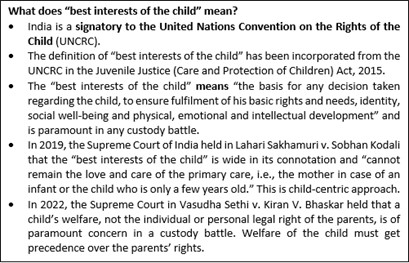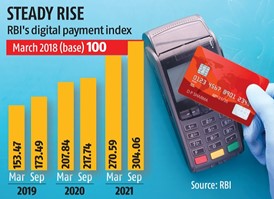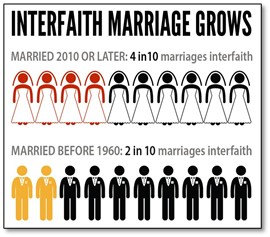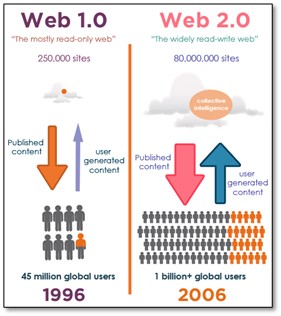Tuesday, 25th January 2022
Onset of Sixth Mass Extinction
In News
A recent study led by the University of Hawaii has stated that earth is going through its sixth mass extinction.
About Mass extinctions
- Extinction is a natural and recurrent phenomenon. About 98% of all the organisms that have ever existed on our planet are now extinct.
- Mass extinction refers to 75% of the world's species being lost in a 'short' amount of geological time - less than 2.8 million years.
- There have been five mass extinction events in the past.
- These extinctions were caused by “catastrophic alterations” to the environment, such as massive volcanic eruptions, depletion of oceanic oxygen or collision with an asteroid.
- After each of these extinctions, it took millions of years to regain species comparable to those that existed before the event.
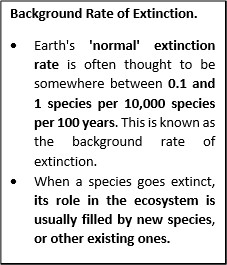
The Sixth Mass Extinction
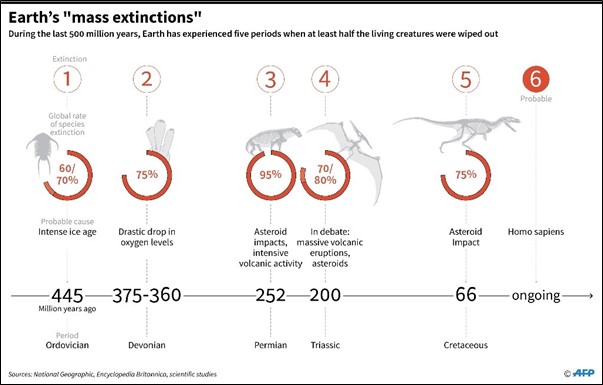
- The Holocene Extinction or the sixth mass extinction hasn’t been defined by a dramatic event like a meteor impact.
- It is made up of the nearly constant string of extinctions that have shaped the last 10,000 years as modern humans came to dominate and populate the Earth.
- Humans have contributed to factors leading to even more extinctions as animal habitats disappear or are disrupted by new species. These factors include:
- climate change caused due to various anthropogenic activities
- increased land use for human consumption,
- culling of large animals for human safety,
- degradation caused due to agricultural activities and industrialisation
- the introduction of invasive species.
- Current rate of species loss is probably a thousand times what the normal rate is. Many of the species going extinct are doing so before they are even identified.
Ways to arrest the extinction event
- Countries should uphold the Paris agreement to limit global warming to well below 2 degrees Celsius, preferably to 1.5 degrees Celsius, compared to pre-industrial levels.
- Cataloguing of species should be done at a fast rate to identify the true rate of extinction.
- Land use and land degradation should be arrested. United Nations Convention to Combat Desertification (UNCCD) adopted in 1994, is the sole legally binding international agreement linking environment and development to sustainable land management.
- The UN Convention on Biological Diversity (CBD) Secretariat has released a new Global Biodiversity Framework to guide actions worldwide through 2030 to preserve and protect nature and its essential services to people, including a 50% of greater reduction in the rate of introduction of invasive alien species, and controls or eradication of such species to eliminate or reduce their impacts.
Sources:
- We are witnessing onset of Sixth Mass Extinction, says study
- Explained: What is the ongoing sixth mass extinction?
- Episode Twelve: Six Extinctions in Six Minutes
- What is mass extinction and are we facing a sixth one?
- Achieving Land Degradation Neutrality
- A New Global Framework for Managing Nature Through 2030: 1st Detailed Draft Agreement Debuts
RADPFI guidelines
In News
A set of new development guidelines to transform rural India- Rural Area Development Plan Formulation and Implementation (RADPFI) have been recently introduced by the government.
These guidelines aim to transform rural India and ensure its empowerment to promote rural prosperity.
About the Guidelines
- Typology of villages: This is to prepare the spatial development plan that will include population, agro-climatic zones, Hill areas, disaster occurrence, urban-peri-urban areas and villages, near to National Highways/State Highways, Resilience strategies etc, as suggested by BIS.
- Land Use Development: The Guidelines deal with different development Land Use standards for different areas, with different characteristics. This will facilitate the planned spatial development of rural areas.
- Village Town Planning Scheme (VPS) – through community based on Collaborative Planning.
- Planning for environmental benefit and disaster preparedness.
- Linking to 15th Central Finance Commission and respective State Finance Commissions.
- Improving the E-Governance through Spatial Data Infrastructure (SDI).
- Integration and Consolidation of Gram Panchayat Development with Rurban Clusters, Block/District Plan, as per the 73rd and 74th Constitutional Amendment Act and Gram Panchayat Development Plan
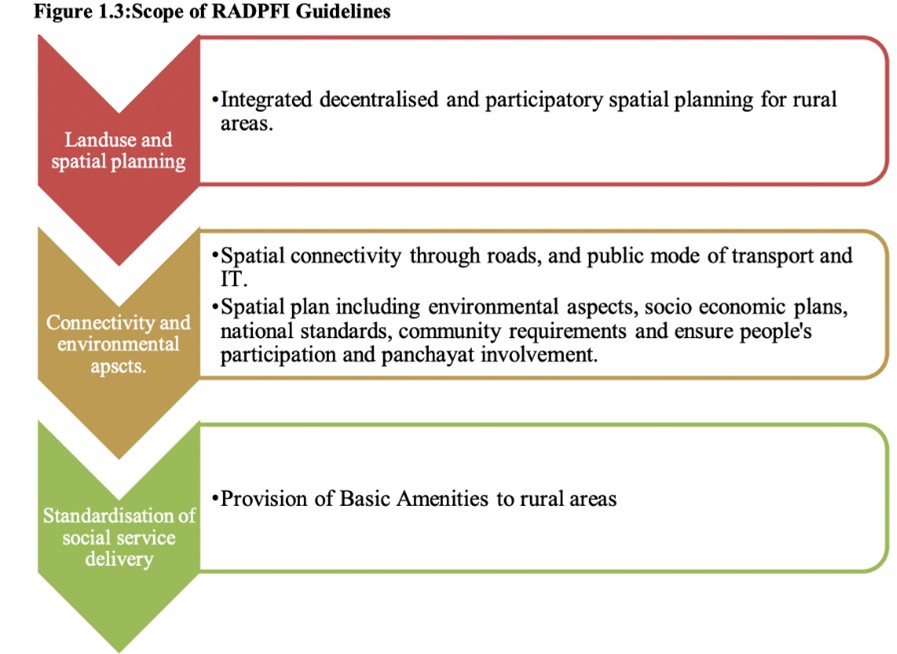
- Using the SVAMITVA and other digital tools for Abadi area linking to land records.
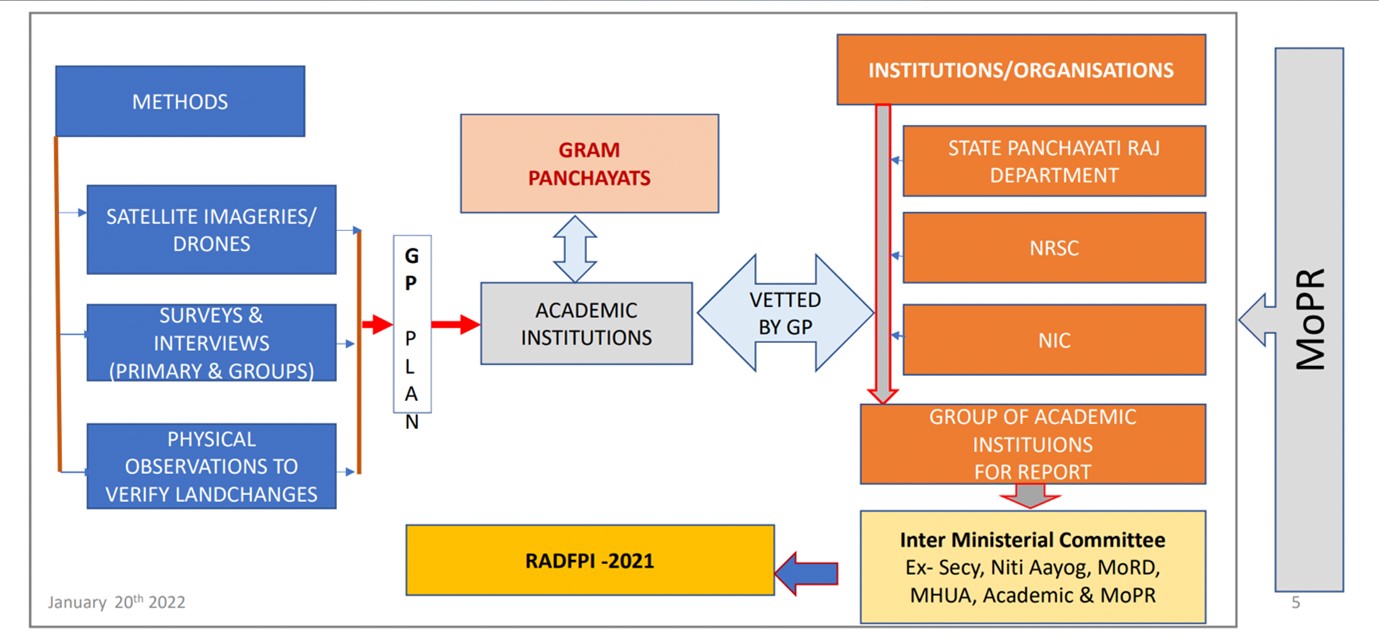
Source:
National Voter’s Day
On January 25, 2011 first-ever National Voters’ Day was celebrated to encourage more young voters to take part in the electoral process. It was formally introduced in 2011 to mark the foundation day of the Election Commission of India (ECI), an autonomous body under the ownership of the Ministry of Law and Justice that aims to ensure free and fair elections in the country. This year, it is the 12th edition which is being celebrated. The day is observed to spread awareness about the importance of voting in a democracy and it also educates people about their voting right. The Right to Vote is such a simple yet complex right known to every citizen in India. The Right to Vote is available in our country to almost everyone equally at 18 years of age irrespective of their religion, gender, education or literacy level. Voting is a fundamental right of every citizen who is of sound mind in India. It helps them to choose the leaders of tomorrow to contribute towards the country’s development.
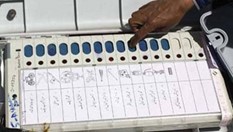
Source:
Election Freebie Culture
In News
A petition has been filed in the Supreme Court seeking a direction to the Election Commission of India (ECI) to seize the election symbol or de-register a political party that promises or distributes “irrational freebies” from public funds before elections.
What is a Freebie?
- Freebies can be defined as something without charge or cost. Freebies have a key place in our Indian election manifesto. There are some other examples of freebies where States provide phones, laptops, grinders, bicycles and free transportations.
- As per Election Commission, Directive Principles of state policy enshrined in Constitution enjoin upon the state to frame various welfare measures for citizens and therefore there can be no objection to the promise of such welfare measures in manifestos.
- The origin of freebie culture in India can be traced to the Tamil Nadu politics. Afterwards political parties across the nation adopted this as one of the doctrines to woo voters.
- The freebie culture started with some outlines such as it would help to enhance the capacity of poor people, to reduce the poverty and to empower the target beneficiaries.
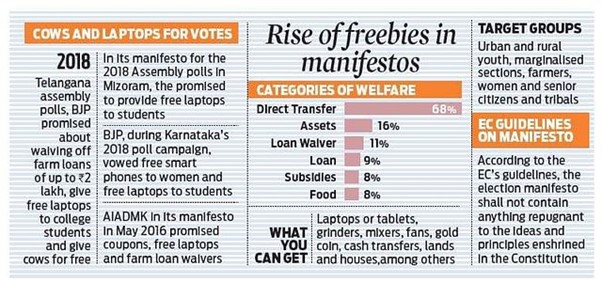
Why is so much importance given to Freebie Politics?
- Appeasement of Voters: Freebies are the best lucrative methods adopted by political parties to lure voters. Despite knowing the fact that these freebies will put State revenue in red zone, political parties are competing with each other to lure the voters.
- Form of Social Welfare: The argument which favours freebies says that it is also another form of social welfare. There are limited studies available in India to find out the impact of freebies on welfare of people.
- To hide Under-performance of political parties: Freebies have become a norm because the political parties are unable to deliver normal projects, have long-term planning, create infrastructure and thereby create job opportunities. The freebie model allows the Government with excuses for its governance and policies over a period, thus neglecting incumbent government’s actual work.
- To silence the Critical Reviews of citizens: These sops ensure that a majority of Indians can stay afloat in a fiercely difficult economic environment. Without this, they might throw governments out of power, or even begin to question what media and public-culture feed them.
- For Popular Support: The Ruling class needs popular support for its rule to continue. The sops and freebies to the poor buy it the requisite votes. It is a small price that India’s affluent have to pay to ensure the economy continues to disproportionately reward them.
What impact do these Freebies have?
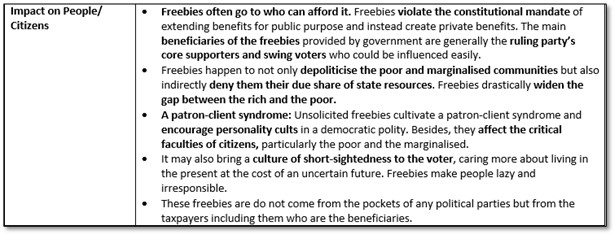
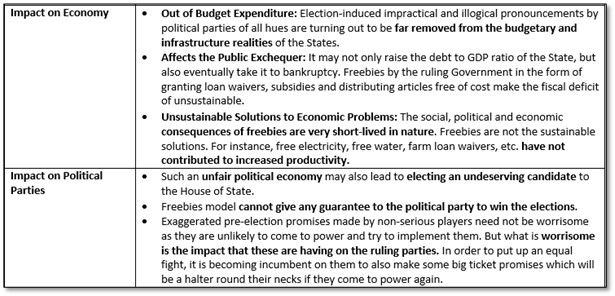
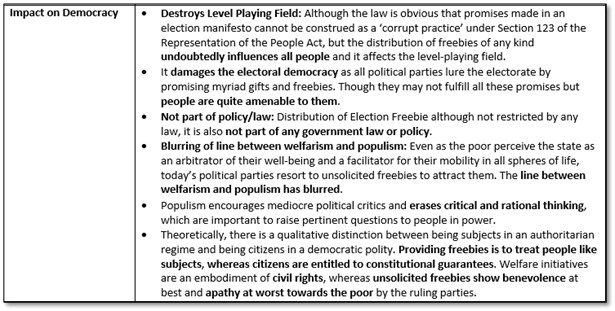
What are the Steps needed to curb the negative impacts of Election Freebies, if not eliminate it?
- Financing of the Freebie needs to be accounted for from the Expenditure – in Manifesto or Budget proposal.
- There I need to draw public’s attention and debate to the dichotomy between welfare and unsolicited freebies or populism, so that the constitutional ideal of a secular, egalitarian and democratic India can be realised.
- An additional condition can be inserted in the relevant paragraphs of the Election Symbols (Reservation and Allotment) Order 1968, which deals with conditions for recognition as a state party, that a "political party shall not promise/distribute irrational freebies from the public fund before the election".
- Given that freebies have historically impacted the socio-economic quality of life. So, if there is a socio-economic benefit to society at large, as has been the case with many of the schemes introduced over the years, then it should not be considered a freebie, but a social security net.
- There is also need for a separate law, to be passed by the legislature, in this regard for governing the political parties.
- If the political parties deliver the normal developmental activities during their five-year tenure, there would be no need to resort to freebies which are short-term measures. If the concept of irresponsible populism is reduced and the governments work seriously and manage funds prudently, the election expenditure can also come down and the country can progress fast.
Conclusion: As per an observation by Y K Alagh, economist and educationist, the electorate is nobody’s fool. It will take all the freebies already being distributed and then vote according to its carefully thought out assessment of performance. Much depends on whether the electorate can see through all this posturing.
Question: Discuss the various impacts of election Freebie culture in India.
Sources:
Rose Shaped Corals
This is image of corals shaped like roses in the waters off the coast of Tahiti of the French Polynesia. The reef is thought to be one of the largest found at such depths and seems untouched by climate change or human activities. The newly found reef stretches 3 kilometers. Unlike most of the world’s mapped corals, which are found in shallow waters, this one was deeper — between 35 meters to 70 meters. Corals are tiny animals that grow and form reefs in oceans around the world. Around the world, coral reefs have been damaged from overfishing and pollution. Climate change is also hurting corals, including those in areas near the newly discovered reef. Between 2009 and 2018, 14 percent of the world’s corals were killed.

Source:
Kerala Bird Atlas (KBA)
- Context: Kerala, has recently received its first scientific bird atla
- It is the first-of-its-kind state-level bird atlas in India and arguably Asia’s largest in terms of geographical extent, sampling effort and species coverage.
- The Atlas has baseline data about the distribution and abundance of various bird species across all major habitats of the State.
- It accounts for nearly three lakh records of 361 species, including 94 very rare species, 103 rare species, 110 common species, 44 very common species, and 10 most abundant species.
- It was prepared based on systematic surveys held twice a year during the wet (July to September) and dry (January to March) seasons between 2015 and 2020.
- The KBA is considered to be a valuable resource for testing various ecological hypotheses and suggesting science-backed conservation measures as birds are excellent indicators of changing ecological circumstances.
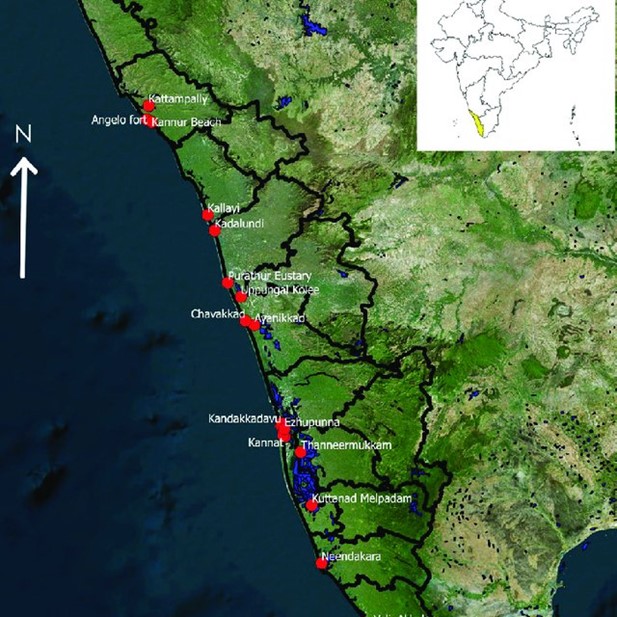
Source:
Image Source:
Sri Ramanujacharya
- Context: The Prime Minister will be unveiling the Statue of Equality in Hyderabad
- The Statue of Equality is the 216-feet statue of Ramanujacharya- the 11th-century saint and social reformer.
- The statue is made of 'panchaloha', a mix of five metals - gold, silver, copper, brass, and zinc respectively and the inner sanctorum deity of Ramanujacharya is made of 120 kg of gold to commemorate the 120 years the saint walked this earth.
- The complex has identical recreations of 108 Divya Desams, the 108 ornately carved Vishnu temples mentioned in the works of the Alwars, mystic Tamil saints.
- Sri Ramanujacharya is best known as the founder of the Vishishtadvaita Vedanta sub school (that claims that all variation is subsumed by an underlying unity. It is a non-dualistic Vedanta philosophy school, in which Brahma is the only thing that exists, but marked by plurality).
- Born in 1017 at Sriperumbudur in Tamil Nadu, he liberated millions from social, cultural, gender, educational, and economic discrimination with the principle that every human is equal regardless of nationality, gender, race, caste, or creed.
- He opened the doors of temples to all people, including those subjected to extreme discrimination. He remains a timeless icon of equality for social reformists around the world.
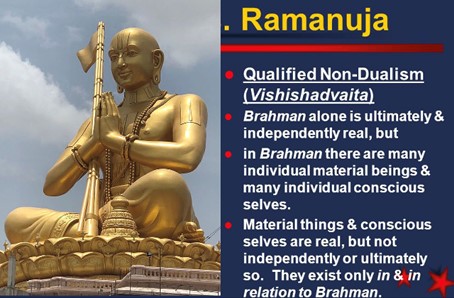
Source:
Image Source:
South Bengal Elephant Corridor
- Context: Environmentalists have undertaken the Ecological Restoration of Elephant corridors in south Bengal.
- This is because, the fragmented and patchy forests of south Bengal have emerged as one of the hotspots of human-elephant conflict in the country, resulting in loss of lives of both humans and the elephants.
- It is noted that between 2014 and 2019, over 2,381 human deaths were recorded in elephant attacks across the country, of which over 16% were from West Bengal.
- The State, however, is home to less than 3% of the elephant population and records a high death count of pachyderms (big mammals like elephants, rhino etc.) in conflicts.
- The major reason for the conflict is the ecological degradation due to increased agricultural activities and community forestry that disturbs the ecological balance and results in the events of elephant infiltrating towns.
- The other associated threats in India include – Habitat loss, Coal and iron mining, poaching, and grazing grounds.
- Elephant corridors are linear, narrow, natural habitat linkages that allow elephants to move between secure habitats without being disturbed by humans.
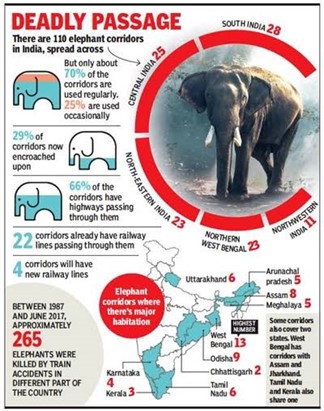
Source:
Subhas Chandra Bose Aapda Prabandhan Puraskaar
- Context: ‘Subhas Chandra Bose Aapda Prabandhan Puraskaar’ has been awarded to The Gujarat Institute of Disaster Management (GIDM) and Professor Vinod Sharma, the founder co-ordinator of the National Centre of Disaster Management.
- ‘Subhas Chandra Bose Aapda Prabandhan Puraskaar’ is an annual award of the Government to recognize and honour the invaluable contribution and selfless service rendered by individuals and organisations in India in the field of disaster management in India.
- It is announced every year on 23rd January, the birth anniversary of the freedom fighter Netaji Subhash Chandra
- The award carries a cash prize of Rs 51 lakh and a certificate in the case of an institution and Rs 5 lakh and a certificate in the case of an individual.
- The Award nomination and distribution is carried out under National Disaster Management Authority, Government of India.
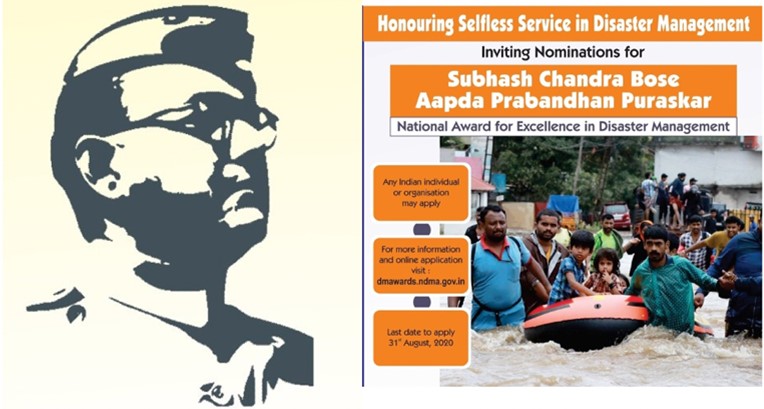
Source:
- Subhash Chandra Bose Aapda Prabandhan Puraskar for '22 declared
- PM Confers Subhash Chandra Bose Awards For Disaster Management For 2019-22
Image Source:
India’s Challenge in European Geopolitics: IE
Essence: The editorial highlights the complex situation of present Europe which is going through many internal and external contradictions. While on one hand, all stakeholders agree on increased China’s assertiveness in the region, there are differences in how unified their effort must be. To have only Europe decide its future (with respect to Ukraine), or have USA participate or demand support from Russia is a question that all European nations are going through.
This is also highlighted in Germany’s navy chief remarks over Russia’s supremacy and impossibility of taking back Crimea by Ukraine.
Issues in integrating nations as a part of EU is a challenge, integrating Russia as a neighbor with acceptable terms, and Europe handing its own security are prominent. In this regard, India must not act with the traditional “East Vs West” approach but weigh the political and diplomatic situation to gain national benefit.
Why you should read this article?
- To understand the contradictions in Europe due to participation of external states.
- To know the role that these internal contradictions have played for India’s subcontinent in the past.
- To analyze the future diplomatic course of action for India in a sensitive situation like the present times in Europe.
Source:
Public spending in India needs to be stepped up: HBL
Essence: The article talks about the decline in government spending for the year 2020-21. With the limited data that is available the results are not so encouraging. To this, parameters like financial performance of the companies and MSME are not added, which fails to provide a complete picture. The graphs not only show falling per capita income but also the rise in income inequality. Also, as the increase in the consumption of the rich tends to be more import intensive, which will not add to the domestic demand.
The government which was expected to add to spending to counterbalance the falling private demand did not take place. Even though the figures of actual spending of the government are about to come, there are signs of significant underspending. To focus on stable and equitable economic recovery people should leave their obsession with the fiscal deficit number. Rather it is the time to focus on numbers like overall public spending and extent of proposed transfers to states.
Why you should read this article?
- To understand the gaps in government spending in the economy.
- To understand data sets on income distribution, estimates of GDP, private expenditure estimates etc.
- The article provides important data points to substantiate the level of government spending in the economy. (GS-3, Economy, Government Spending).
Source:
The devastating impact of school closure: TH
Essence: Omicron is a more transmissible yet milder version of Delta. Irrational response to Omicron like closing of schools has had a particularly negative influence on youngsters. Despite the Omicron increase, most other countries have kept their schools open, putting children's welfare first. According to new research, the risk of COVID-19 infection in people under the age of 25 is substantially lower than the risk of traffic accidents.
As per survey report from September 2021, Children's reading and writing skills have deteriorated, with over half unable to read more than a few words. Apart from this, mental health difficulties, malnutrition is a significant problem, and we have made it worse by ignoring mid-day meals. Due to longer school closures, decades of progress against the acute cruelty of child labour has been undone. Another school-related fallacy is that they are only safe after students have been vaccinated against COVID-19. This violates logic as well, because schools opened in a number of other nations before adults were vaccinated. Education is a fundamental right guaranteed by the United States Constitution. We have violated children's rights by closing schools for so long and giving a substandard substitute in the form of online education.
Why should you read this question?
- To know the impact of school closure on children.
- To know how closure of schools are violating their fundamental right to study.
Source:
The Delhi EV Policy
Background
- Delhi government has launched an all-in-one e-vehicle website.
- The policy recognizes that a new approach is required to kick-start the adoption of Electric Vehicle in Delhi, as despite the Govt. push, the pace of adoption of Electric vehicles failed to meet the expectations.
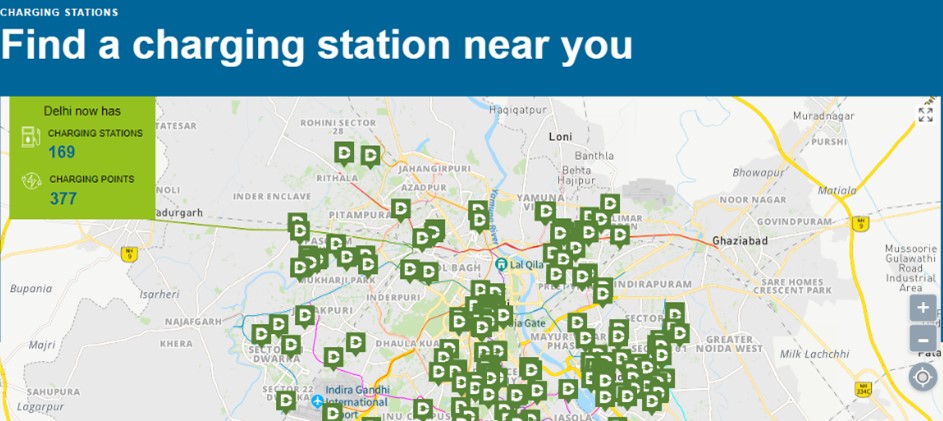
About Electric Vehicle Policy
- The Delhi EV Policy is aimed at reducing air pollution.
- The primary objective of the Delhi Electric Vehicle Policy, 2020 (in short “Policy”) is to establish Delhi as the EV capital of India and accelerate the pace of EV adoption across vehicle segments, especially in the mass category of two wheelers, public/shared transport vehicles and goods carriers.
- The website of the EV Policy is intended to be adaptable, browser-independent, and to serve as a crucial information resource for electric car purchasers, manufacturers, academics, and EV enthusiasts alike.
- It enables the consumers to make a rational choice and identify the cost reduction that an EV can provide. These policy also want to help Delhi's economy recover after a setback caused by the coronavirus. This programme will provide a significant boost to the city's economy.
- The Policy will also seek to put in place measures to support the creation of jobs in driving, selling, financing, servicing and charging of Electric Vehicles.
- Delhi now boasts over one lakh electric vehicles, and locals have reacted positively to the policy, with adoption increasing by a factor of ten.
Quote: “It is time for a sustainable energy policy which puts consumers, the environment, human health, and peace first.” – Dennis Kucinich.
Source:
Share the article
Get Latest Updates on Offers, Event dates, and free Mentorship sessions.

Get in touch with our Expert Academic Counsellors 👋
FAQs
UPSC Daily Current Affairs focuses on learning current events on a daily basis. An aspirant needs to study regular and updated information about current events, news, and relevant topics that are important for UPSC aspirants. It covers national and international affairs, government policies, socio-economic issues, science and technology advancements, and more.
UPSC Daily Current Affairs provides aspirants with a concise and comprehensive overview of the latest happenings and developments across various fields. It helps aspirants stay updated with current affairs and provides them with valuable insights and analysis, which are essential for answering questions in the UPSC examinations. It enhances their knowledge, analytical skills, and ability to connect current affairs with the UPSC syllabus.
UPSC Daily Current Affairs covers a wide range of topics, including politics, economics, science and technology, environment, social issues, governance, international relations, and more. It offers news summaries, in-depth analyses, editorials, opinion pieces, and relevant study materials. It also provides practice questions and quizzes to help aspirants test their understanding of current affairs.
Edukemy's UPSC Daily Current Affairs can be accessed through:
- UPSC Daily Current Affairs can be accessed through Current Affairs tab at the top of the Main Page of Edukemy.
- Edukemy Mobile app: The Daily Current Affairs can also be access through Edukemy Mobile App.
- Social media: Follow Edukemy’s official social media accounts or pages that provide UPSC Daily Current Affairs updates, including Facebook, Twitter, or Telegram channels.

